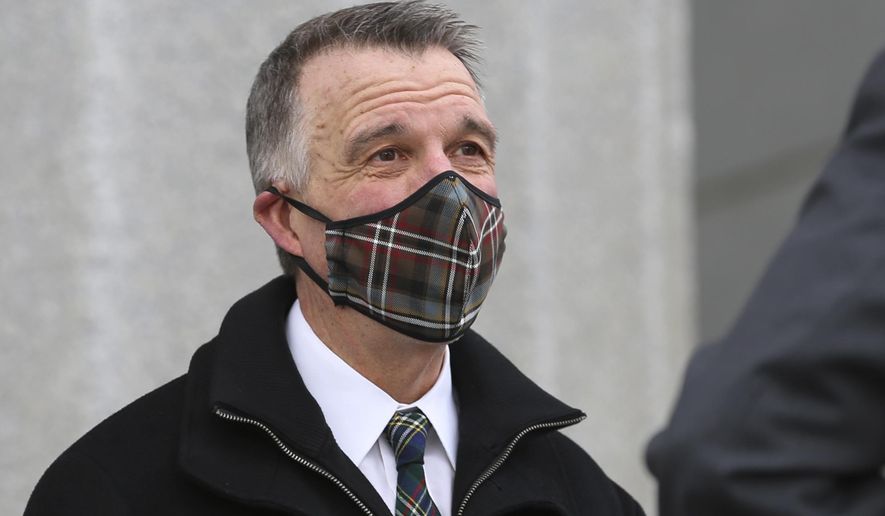Vermont Gov. Phil Scott and the state’s top health official are among those quarantining after possible exposure to the coronavirus, the governor’s office announced late Tuesday.
Scott, Health Commissioner Dr. Mark Levine and other administration officials were told that a contractor who provided services for coronavirus briefings on Jan. 15 and Tuesday had tested positive for COVID-19, news outlets reported, citing a statement from the governor’s office.
The briefings are conducted with safety protocols, but officials decided to take caution and quarantine as they had spent extended periods of time speaking at the lectern, the statement said. The officials will be tested based on guidance from the Vermont Department of Health, and the Republican governor will execute his duties remotely.
The governor’s office has reached out to those in attendance at the two briefings, and the health department will also contact attendees. The statement didn’t say whether Scott, 62, or any of the other officials had exhibited symptoms.
Earlier Tuesday, officials said the number of new COVID-19 cases reported in Vermont is starting to decrease, giving way to cautious optimism that the third wave of the virus was at an end in the state.
In addition to the reduction in the new cases in Vermont and across the region, hospitalizations are down slightly and it’s been several days since Vermont has seen a COVID-19 fatality, officials said.
But the numbers are still significantly higher than they were several months ago and it’s unclear how long it will take before those numbers decrease enough to begin further loosening of restrictions meant to slow the spread of the virus.
That comes as state officials are planning for the second phase of the vaccine campaign, for people over age 75. But the vaccination efforts are hampered by not knowing how much vaccine the state will receive, officials say.
“Uncertainty about the allocations coming to Vermont means there is no real opportunity to change our approach currently,” Levine said Tuesday during the twice-weekly virus briefing. “The age-prioritization approach to saving lives is indeed our north star. It is data driven and simple.”
After older Vermonters are vaccinated, the focus will shift to people between 18 and 64 who have underlying conditions that make them more susceptible to complications from the virus.
___
HOME RECOVERY
A Vermont hospital is developing a plan that would allow COVID-19 patients to recover at homes, rather than in the hospital.
Kathleen Boyd of the Rutland Regional Medical Center is working with other providers to develop the system as part of discharge planning for patients who are willing and if they have support at home.
Boyd told the Rutland Herald the program is national, but they are developing it for local use.
“We wanted to make sure that people who are being admitted to the hospital (are the ones who) require care that can only be delivered at a hospital,” Boyd said.
Dr. Rick Hildebrant, the chief medical information officer at the Rutland hospital, said that typically 2% to 5% of all COVID-19 patients will require hospitalization. About a quarter of those could be eligible for the home-care program.
“These are people who are pretty sick,” Hildebrant said Tuesday.
As important as the clinical criteria is in determining who would be eligible is the social component. Patients need to have support at home.
But if the hospital gets hit hard by COVID-19 admissions, the program could help free up space in the hospital, he said.
It’s expected the program will begin within the next few weeks.
___
NUMBERS
The Vermont Department of Health reported more than 100 confirmed new cases of the virus Tuesday, bringing the statewide total since the pandemic began to more than 10,320.
There were 40 people hospitalized, including five patients in intensive care.
The seven-day rolling average of daily new cases in Vermont has risen over the past two weeks from 107.57 new cases per day on Jan. 4 to 163.14 new cases per day on Jan. 18.
The latest average positivity rate in Vermont is 2.41%. State health departments are calculating positivity rate differently across the country, but for Vermont the AP calculates the rate by dividing new cases by test specimens using data from The COVID Tracking Project.
The seven-day rolling average of the positivity rate in Vermont did not increase over the past two weeks, going from 2.7% on Jan. 4 to 2.41% on Jan. 18.




Please read our comment policy before commenting.